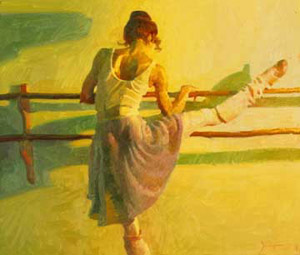 You should feel this stretch throughout your entire backside — heel, calf, hamstring, lower back, and lats. Try not to tighten your shoulders and round your back during this stretch. Stay in your comfort zone during this stretch. Remember that you’re introducing range of motion, not trying to increase your overall flexibility.
You should feel this stretch throughout your entire backside — heel, calf, hamstring, lower back, and lats. Try not to tighten your shoulders and round your back during this stretch. Stay in your comfort zone during this stretch. Remember that you’re introducing range of motion, not trying to increase your overall flexibility.To do this stretch, follow these steps:
- Stand with your feet in a wide stance about hip-width apart.
- Extend your left leg so your heel on your right leg remains on the floor and your toes on the left leg are lifted toward the ceiling.
- Bend your right knee as you slowly press your hips back (see Figure a).
- Reach your right hand toward your left toes or the outside of your left leg (see Figure b).
- Hold the stretch for 30 seconds and then repeat on the other side.
- Do tilt your pelvis back.
- Do try to keep your back flat.
- Do keep your foot flexed and your toes pointed up.
- Don’t bounce or force the stretch.
- Don’t tighten up your shoulders or round your back.








